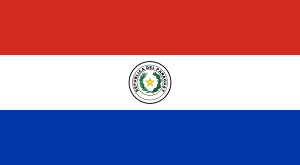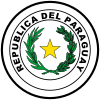Paraguayans
This article needs additional citations for verification. (September 2023) |
 | |
| Regions with significant populations | |
|---|---|
| 690,948[2] | |
| 64,547[2] | |
| 52,770[2] | |
| 34,307[2] | |
| 8,000[3] | |
| 2,215[4] | |
| Languages | |
| Paraguayan Spanish, Guarani, other indigenous languages, Portuguese German[5] | |
| Religion | |
| Predominantly Roman Catholicism, Protestantism, indigenous religions[6] | |
Paraguayans (Spanish: paraguayos) are the citizens of Paraguay.
Though the majority of Paraguayans reside in Paraguay, significant communities have been established in multiple countries, most noticeably Argentina, Spain, United States, Brazil.
History
[edit]The first inhabitants of Paraguay were the Guarani people.[7]
Racial and ethnic groups
[edit]As in other Latin American countries, in Paraguay, from the onset of Spanish colonization and settlement, miscegenation or mestizaje was the norm rather than the exception. Paraguay has one of the most homogeneous populations in South America. About 75% of the people are mestizo (mixed Spanish and Guaraní Native American descent), 20% are Whites, and the rest are small minorities of Indigenous or Afro Paraguayan origin.[8]
European or white
[edit]Indigenous
[edit]While only a 1.7% of Paraguay's population is fully indigenous according to the 2012 national census, 75% of the population identifies as being partially of indigenous descent;[10] however, the majority do not identify as being indigenous but as Mestizos.
Languages
[edit]Paraguay is predominantly a bilingual country, as the majority of the population uses Spanish and Guaraní. The Constitution of Paraguay of 1992 established Spanish and Guaraní as official languages.[11] Spanish, an Indo-European language of the Romance branch, is understood by about 90% of the population as a first or second language. Guaraní, an indigenous language of the Tupian family, is understood by 77%, and its use is regulated by the Academy of the Guaraní Language.[12][13]
According to Instituto Cervantes' 2020 report "El Español: Una lengua viva", 68.2% of the Paraguayan population (4,946,322 inhabitants) has decent mastery of the Spanish language. The remaining 31.8% (2,306,350 inhabitants) belongs to the Group of Limited Competence, having minimal mastery of the language; the majority of them are Guaraní speakers and speak Spanish as a second language.[14] Only 7.93% are monolingual in Guaraní.[15]
Population
[edit]| # | Department | Population (2022 census)[16] |
|---|---|---|
| 1 | 1 866 562 | |
| 2 | 784 839 | |
| 3 | 477 346 | |
| 4 | 436 966 | |
| 5 | 430 142 | |
| 6 | 341 895 | |
| 7 | 271 475 | |
| 8 | 204 536 | |
| 9 | 199 430 | |
| 10 | 189 128 | |
| 11 | 180 121 | |
| 12 | 173 770 | |
| 13 | 140 060 | |
| 14 | 126 880 | |
| 15 | 114 542 | |
| 16 | 85 749 | |
| 17 | 68 595 | |
| 18 | 17 608 | |
| Total | 6 109 644 | |
Sex
[edit]- Men: 3 078 994: 50,3%
- Women: 3 030 650: 49,7%
Classification
[edit]See also
[edit]References
[edit]- ^ "Paraguay has 6,109,644 inhabitants, according to the last Census". ABC Color (in Spanish). 31 August 2023. Archived from the original on 5 September 2023. Retrieved 14 May 2024.
- ^ a b c d "Paraguay - Emigrantes totales 2019 - Datosmacro.com" (in Spanish).
- ^ "Immigrant and Emigrant Populations by Country of Origin and Destination". Migration Policy Institute.
- ^ "在留外国人統計(旧登録外国人統計)" (in Japanese). 15 December 2023. Retrieved 28 April 2024.
- ^ "Paraguay - World Directory of Minorities & Indigenous Peoples".
- ^ "Paraguayans".
- ^ "history - PARAGUAY".
- ^ a b Francisco Lizcano Fernández (2005). "Composición Étnica de las Tres Áreas Culturales del Continente Americano al Comienzo del Siglo XXI" [Ethnic Composition of the Three Cultural Areas of the American Continent at the Beginning of the 21st Century]. Convergencia. Revista de Ciencias Sociales (in Spanish). 12 (38): 185–232.
- ^ Lizcano Fernández, Francisco (2004). "Las etnias centroamericanas en la segunda mitad del siglo XX" (PDF). Revista Mexicana del Caribe. IX (17). Retrieved 2011-05-04.
- ^ "Paraguay: Ethnic Groups." CIA: The World Factbook. (retrieved 12 July 2011)
- ^ "Paraguay - Constitution, Article 140 About Languages". Retrieved 3 December 2007 – via International Constitutional Law Project. (see translator's note)
- ^ "Paraguay". 1 June 2011. Archived from the original on 1 June 2011. Retrieved 2 December 2023.
- ^ Espinoza, Ariel (24 August 2012). "Guaraní: Identidad histórica paraguaya". ABC (in Spanish). Retrieved 2 December 2023.
- ^ Instituto Cervantes. El español: una lengua viva. Informe 2020 (PDF). Retrieved 2 December 2023 – via cvc.cervantes.es.
- ^ Instituto Cervantes. El español: una lengua viva. Informe 2020 (PDF). Retrieved 2 December 2023 – via cvc.cervantes.es.
- ^ "Censo Nacional de Población y Viviendas 2022 - Resultados Preliminares" (PDF). Instituto Nacional de Estadística. 31 August 2023. Retrieved 2 December 2023.

